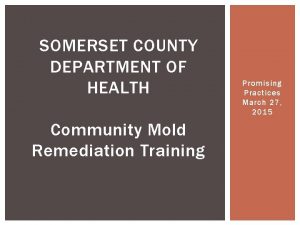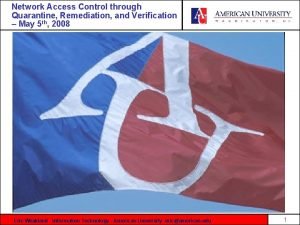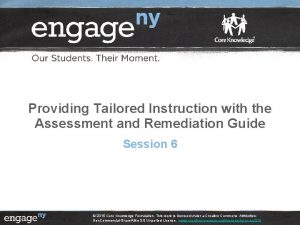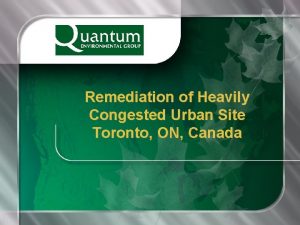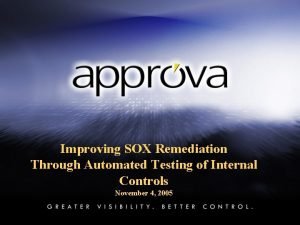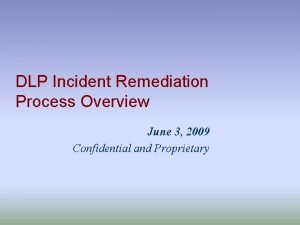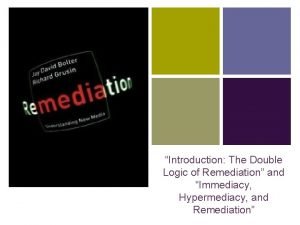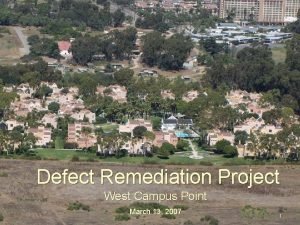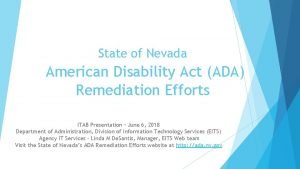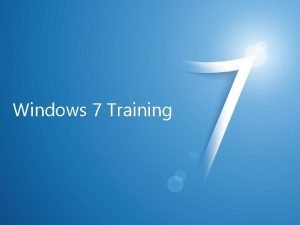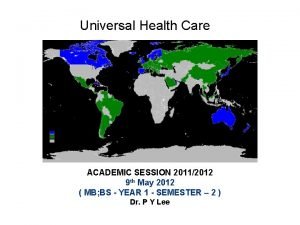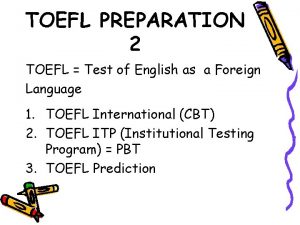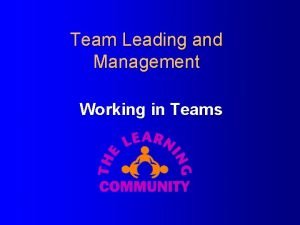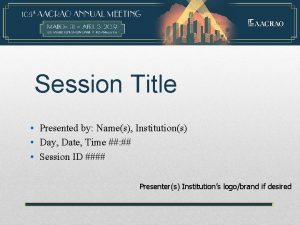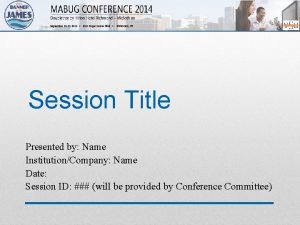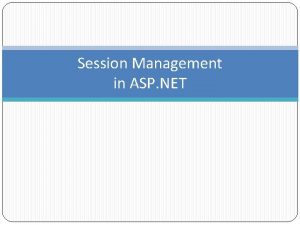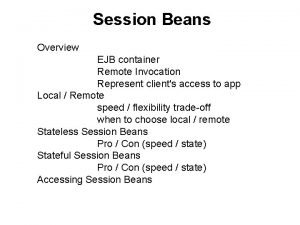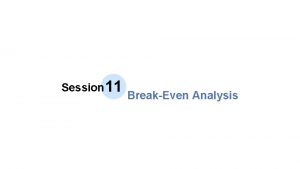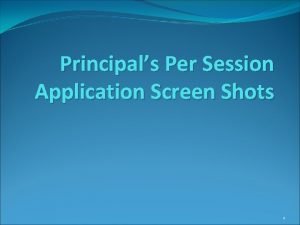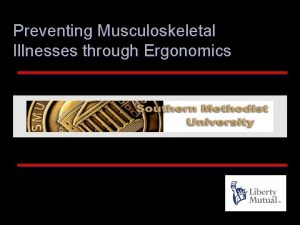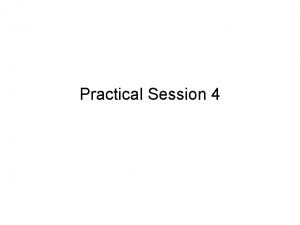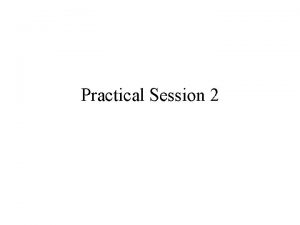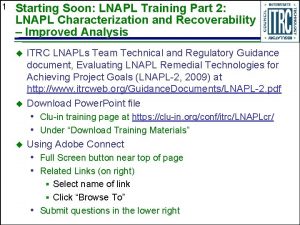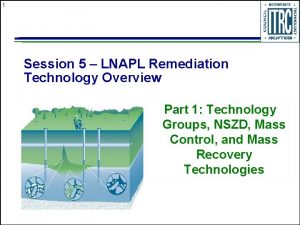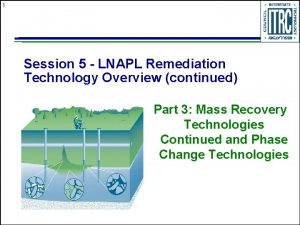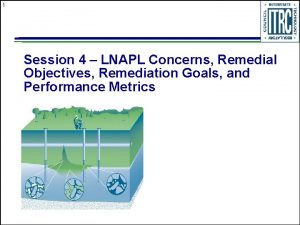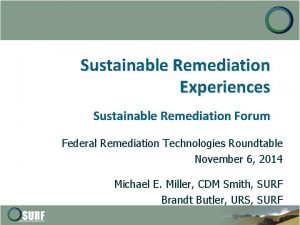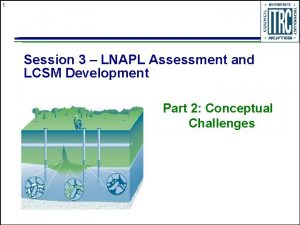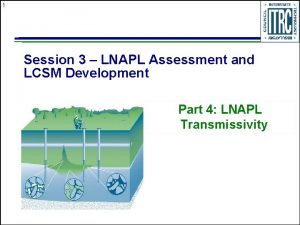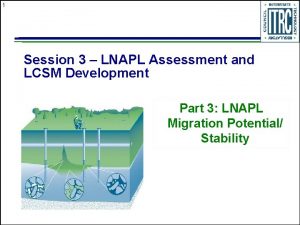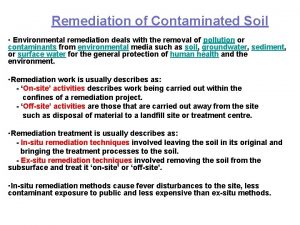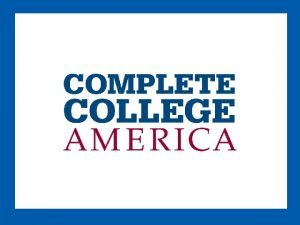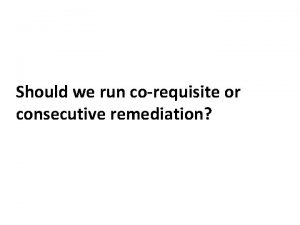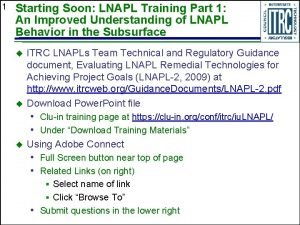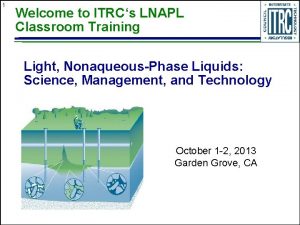1 Session 6 LNAPL Remediation Technology Selection 2



































- Slides: 35

1 Session 6 – LNAPL Remediation Technology Selection

2 Introduction ITRC LNAPL Management Paradigm LNAPL Assessment LCSM What do you have? Set LNAPL Remediation Objectives What needs to be done? Select Remediation Technology to Achieve Objectives How to address it? Deploy Remedial Technology and Monitor Performance

3 Guidance Doc Process Flow Diagram Guidance Doc Sections 3, 4, and 6. 1 LNAPL characterization Develop LCSM IBT-1, 2 Sections 3 &4 Identify LNAPL concerns Section 6 Introduction Identify LNAPL objectives, goals, site/LNAPL condition to screen technologies (Screening Step 1: Table 6 -1) Screen technologies: Geology factors (Screening Step 2: Tables A) Screen technologies: Evaluation factors (Screening Step 3: Tables B) Section 7 Minimum data requirements and critical technology Group (Tables C) Section 8 Establish goals and metrics and implement LNAPL remediation Monitor/assess LNAPL remediation performance Demonstrate goals met

4 Guidance Doc Process Flow Diagram Guidance Doc Sections 6. 2, 7, and 8 LNAPL characterization Develop LCSM IBT-1, 2 Sections 3&4 Identify LNAPL concerns Section 6 Introduction Identify LNAPL objectives, goals, site/LNAPL condition to screen technologies (Screening Step 1: Table 6 -1) Screen technologies: Geology factors (Screening Step 2: Tables A) Screen technologies: Evaluation factors (Screening Step 3: Tables B) Section 7 Minimum data requirements and critical technology Group (Tables C) Section 8 Establish goals and metrics and implement LNAPL remediation Monitor/assess LNAPL remediation performance Demonstrate goals met To Cover

5 Process Flow - Quick Aside LNAPL characterization Develop LCSM IBT-1, 2 Sections 3&4 Identify LNAPL concerns Passive LNAPL Management versus Section 6 Technology Selection? Identify LNAPL objectives, goals, site/LNAPL condition to screen Introduction technologies (Screening Step 1: Table 6 -1) Screen technologies: Geology factors (Screening Step 2: Tables A) Screen technologies: Evaluation factors (Screening Step 3: Tables B) Collect additional Section 7 data or further evaluate objectives, Minimum data requirements and critical technology Group (Tables C) goals or Section 8 technologies as Establish goals and metrics and implement LNAPL remediation needed. Make sure the data will be Monitor/assess LNAPL remediation performance used. Demonstrate goals met

Introduction 6 LNAPL Remediation Technology Selection Learning Objectives: u How to use the Guidance Doc Screening Tool u How the Guidance Doc can be applied to a real site Let’s test drive the Guidance Doc!

7 Section 6 – Preliminary LNAPL Remedial Technology Screening Goal: 17 technologies to 5 or less u 2 -step process u Stepped Process • Step 1 – Table 6 -1, p. 36 § We have identified – LNAPL Remedial Objectives – LNAPL Remediation Goals – Technology Group(s) – Performance Metrics, § Screen technologies according to site conditions • Step 2 – Compare screened technologies against Geologic Factors in “A-series” tables in Appendix A to further refine list

8 Reminder (Guidance Doc p. 36) Section 6, Step 1 Table 6 -1: Identify Objectives, Goals, Technology Group And Metrics To Address LNAPL Concerns

9 LNAPL Technology and LNAPL/Site Conditions Step 2, Guidance Doc Table 6 -1, p. 36 Table 6 -1. Preliminary Screening Matrix Section 6, Step 2 LNAPL Remedial Objective u LNAPL Remedial Goal Technology Group Example Performance Metrics • Limits of technology • Asymptotic mass removal Further abate Reduce LNAPL • Cost of mass LNAPL beyond when LNAPL is LNAPL mass removal hydraulic or within residual recovery • Soil pneumatic saturation range concentration recovery at regulatory standard LNAPL Technology and LNAPL / Site Conditions • Cosolvent flushing C, S, LV, LS, HV, HS • SESR C, S, LV, LS, HV, HS • AS/SVE C, U, S, HV, HS • ISCO C, U**, S, HV, HS • RFH F, U, S, LV, LS, HV, HS • 3 - and 6 -phase heating F, U, S, LV, LS, HV, HS • Steam/hot-air injection C, U, S, LV, LS, HV, HS • NSZD F, C, U, S, HV, HS A grouping of technologies can be further reduced based on • LNAPL type § LV- low Volatility, HV-High Volatility, HS-High Solubility, LS-Low Solubility • Geologic indicators § F-Fine grained soils, C-Coarse grained soils, U-unsaturated zone, Saturated zone S-

10 Reminder: Guidance Doc Technology Series Tables Guidance Doc Appendix A (pp. A-1 to A-64) u A group of tables (Tables A, B and C) for each of the 17 LNAPL remediation technologies u • A-series – general technology information • B-series – evaluation factors • C-series – technical implementation considerations For a technology, the A, B and C tables are presented on consecutive pages u Key literature references presented in the tables u Key Point: Appendix A presents typical technology applicability to site conditions as concluded by the LNAPL Team. This doesn’t mean you can’t apply the technology in a setting different than what is presented.

11 Case Study Example: Introduction u Service Station • Gasoline with some diesel LNAPL body Case Study § ~700’ by 200’ § Water table ~30’ bgs • Medium sands § Overlying bedrock at ~40 bgs • LNAPL in monitoring wells (generally <1 ft) • BTEX and MTBE groundwater plumes • Possible vapor intrusion/explosive vapor concerns

12 Case Study Example: Map LNAPL

13 Case Study Example: Cross Section LNAPL High Water Table

14 Case Study Example: LNAPL Concern u Migration • Possible seeps from soil Case Study through cracks into storm drain LNAPL near neighbors’ buildings u Dissolved and vapor plume u • Dissolved plume toward Pacific (but no expansion) • Vapor plume near neighboring property

15 Case Study Example: Guidance Doc Table 6 -1 (Step 1) Table 6 -1. Preliminary Screening Matrix Case Study, Step 1 LNAPL Remedial Objective u LNAPL Technology Remedial Goal Group Example Performance Metrics • Limits of technology • Asymptotic mass removal Further abate Reduce LNAPL • Cost of mass LNAPL beyond when LNAPL is LNAPL mass removal hydraulic or recovery within residual • Soil pneumatic saturation range concentration at recovery regulatory standard LNAPL Technology and LNAPL/Site Conditions • Cosolvent flushing C, S, LV, LS, HV, HS • SESR C, S, LV, LS, HV, HS • AS/SVE C, U, S, HV, HS • ISCO C, U**, S, HV, HS • RFH F, U, S, LV, LS, HV, HS • 3 - and 6 -phase heating F, U, S, LV, LS, HV, HS • Steam/hot-air injection C, U, S, LV, LS, HV, HS • NSZD F, C, U, S, HV, HS Screen out RFH and Three- and Six-phase heating • Geologic indicators § F-Fine grained soils

16 Starting with Section 6: Step 2 LNAPL characterization Develop LCSM IBT-1, 2 Sections 3&4 Identify LNAPL concerns Section 6, Step 2 Identify LNAPL objectives, goals, site/LNAPL condition to screen technologies (Screening Step 1: Table 6 -1) Screen technologies: Geology factors (Screening Step 2: Tables A) Screen technologies: Evaluation factors (Screening Step 3: Tables B) Section 7 Minimum data requirements and critical technology Group (Tables C) Section 8 Establish goals and metrics and implement LNAPL remediation Monitor/assess LNAPL remediation performance Demonstrate goals met You are here

17 Example: AS/SVE Guidance Doc Table A-5. A (p. A-13) Section 6, Step 2 Geologic factors Saturated Permeability AS may be most effective in moderatezone permeability materials, which are less prone to severe air channeling but do not severely restrict air flow.

18 Case Study Example: A-Series Tables u Site Geologic factors Case Study , Step 2 • Moderate permeability • Unsaturated and saturated zone impacts (typical smear zone) • Generally homogeneous soil profile Excerpt from Table A-15. A. Steam/hot-air injection Geologic factors Saturated Permeability Steam injection is effective only in relatively zone permeable materials where there is less resistance to flow; also, more effective in confined LNAPL settings where a lowpermeability layer can help to control steam distribution.

19 Case Study Example: Technology Screening • Cosolvent flushing C, S, LV, LS, HV, HS Case Study, Step 2 • SESR C, S, LV, LS, HV, HS • AS/SVE C, U, S, HV, HS • ISCO C, U**, S, HV, HS • RFH F, U, S, LV, LS, HV, HS • 3 - and 6 -phase heating F, U, S, LV, LS, HV, HS • Steam/hot-air injection C, U, S, LV, LS, HV, HS • NSZD F, C, U, S, HV, HS

20 Section 7 In The Process LNAPL characterization Develop LCSM IBT-1, 2 Sections 3&4 Identify LNAPL concerns Section 6 Section 7, Step 3 Identify LNAPL objectives, goals, site/LNAPL condition to screen technologies (Screening Step 1: Table 6 -1) Screen technologies: Geology factors (Screening Step 2: Tables A) Screen technologies: Evaluation factors (Screening Step 3: Tables B) Section 7 Minimum data requirements and critical technology Group (Tables C) Section 8 Establish goals and metrics and implement LNAPL remediation Monitor/assess LNAPL remediation performance Demonstrate goals met You are here

21 Section 7 – LNAPL Technology Evaluation for the Short List Further evaluate technologies from Section 6 if more than one technology – or – reevaluate goals u Review Table 7 -1 to understand evaluation factors (p. 42) u Select and rank top 5 factors in importance for site considerations u Review “B-series” tables in Appendix A Section 7, Step 3 u

22 Section 7 – Guidance Doc Table 7 -1 Evaluation Factors (p. 42) Section 7, Step 3 Remedial Defined Time Frame Impact The time frame by which the LNAPL remedial goal is to be met. The time frame may be a regulatory or non-regulatory evaluation factor. Holding all other variables the same, the shorter the time frame, the more aggressive the effort required, which increases costs.

Section 7, Step 3 23 Section 7 – Guidance Doc Table 7 -1 Evaluation Factors (p. 42) u Remedial time frame u Safety u Waste stream generation and management u Community concerns u Carbon footprint/energy requirements u Site restrictions u LNAPL body size u Cost u Other Each factor is Defined and its Impact is listed

24 Example: SESR – Guidance Doc Table A-13. B (p. A-45) Technology: Section 7, Step 3 Safety Waste Management Surfactant-Enhanced Subsurface Remediation Concern Low to Moderate …there may be safety issues due to the Discussion equipment used to inject the surfactant and treat the extracted mixture. Concern Moderate …can pose challenges for aqueous. Discussion phase treatment systems. Photo: Intera

25 Case Study Example: Evaluation Factors Case Study, Section 7 Application u Safety • Site is adjacent to freeway and a freeway entrance ramp u Waste Stream Management • Cannot handle large waste water volume u Remedial Time Frame • Not critical but must show progress u LNAPL body size • Treating moderate sized area ~200’ by 200’

Case Study, Section 7 Application 26 Case Study Example: Evaluation Factors Cosolvent (A-14. B) SESR (A-13. B) AS/SVE (A-5. B) ISCO (A-12. B) NSZD (A-4. B) Safety Moderate Low Moderate to High Low Waste Management (Water) High Low Low Remedial Time Frame Very Low to Low Low to Moderate Very Low to Low High to Very High LNAPL Body Size Moderate High

27 Case Study Example: Technology Screening • Cosolvent flushing C, S, LV, LS, HV, HS • SESR C, S, LV, LS, HV, HS Section 7 • AS/SVE C, U, S, HV, HS • ISCO C, U**, S, HV, HS • RFH F, U, S, LV, LS, HV, HS • 3 - and 6 -phase heating F, U, S, LV, LS, HV, HS • Steam/hot-air injection C, U, S, LV, LS, HV, HS • NSZD F, C, U, S, HV, HS

28 Section 8 In The Process LNAPL characterization Develop LCSM IBT-1, 2 Sections 3&4 Identify LNAPL concerns Section 6 Identify LNAPL objectives, goals, site/LNAPL condition to screen technologies (Screening Step 1: Table 6 -1) Section 8 Screen technologies: Geology factors (Screening Step 2: Tables A) Screen technologies: Evaluation factors (Screening Step 3: Tables B) Section 7 Minimum data requirements and critical technology Group (Tables C) Section 8 Establish goals and metrics and implement LNAPL remediation Monitor/assess LNAPL remediation performance Demonstrate goals met You are here

29 Section 8 – Minimum Data Requirements and Critical Considerations For Technology Evaluation Table 8 -1 is a summary table of the critical information (p. 46 -47) u Further evaluate considering bench or pilot test or field deployment information u Use the “C-series” tables in Appendix A for the technologies remaining from Section 7 (e. g. , A-5. C, p. A-15) u If no technology can be determined, reevaluate the objectives or goals Section 8 u

30 Section 8 – Critical Criteria Guidance Doc Table 8 -1 (p. 46 - 47) Minimum data requirements LNAPL Technology (Appendix A Table with further details) ISCO (A-12. C) Site Specific Data for Technology Evaluation Bench Scale Testing Kgw, LNAPLc, homogeneity Soil cores for column test, COCs, LNAPLc Pilot Testing ROI Full-Scale Design ROI, soil oxidant demand, homogeneity Photos: ARCADIS

31 Case Study Example: Technology Screening Case Study Section 8 Application • Cosolvent flushing C, S, LV, LS, HV, HS • SESR C, S, LV, LS, HV, HS • AS/SVE C, U, S, HV, HS • ISCO C, U**, S, HV, HS • RFH F, U, S, LV, LS, HV, HS • 3 - and 6 -phase heating F, U, S, LV, LS, HV, HS • Steam/hot-air injection C, U, S, LV, LS, HV, HS • NSZD F, C, U, S, HV, HS

Case Study Section 8 Application 32 Case Study Example: AS/SVE Selected

33 Establish Goals, Implement, Monitor LNAPL characterization Develop LCSM IBT-1, 2 Sections 3&4 Identify LNAPL concerns Section 6 Identify LNAPL objectives, goals, site/LNAPL condition to screen technologies (Screening Step 1: Table 6 -1) Section 8 Screen technologies: Geology factors (Screening Step 2: Tables A) Screen technologies: Evaluation factors (Screening Step 3: Tables B) Section 7 Minimum data requirements and critical technology Group (Tables C) Section 8 Establish goals and metrics and implement LNAPL remediation Monitor/assess LNAPL remediation performance Demonstrate goals met You are here

34 Take Aways Need a robust LCSM u The Guidance Doc Technology Selection Framework is systematic u Decide the concerns/objectives upfront, though u Repeat process for each concern/objective u Use the technology that overlaps the multiple concerns/objectives u Sequence the technologies as appropriate u Set the performance metrics to know success u

35 Remedial Technology Selection Exercise Sharkey’s
 Somerset mold removal
Somerset mold removal Nac remediation
Nac remediation Ckla assessment and remediation guide
Ckla assessment and remediation guide Remediation of the struggling medical learner
Remediation of the struggling medical learner Site remediation toronto
Site remediation toronto Sox remediation software
Sox remediation software Dlp incident management process
Dlp incident management process Double logic of remediation
Double logic of remediation Wcp envelope
Wcp envelope Nevada eits
Nevada eits Remediation plan in change lifecycle
Remediation plan in change lifecycle Balancing selection vs stabilizing selection
Balancing selection vs stabilizing selection Similarities
Similarities K selection r selection
K selection r selection Natural selection vs artificial selection
Natural selection vs artificial selection Difference between continuous and discontinuous variation
Difference between continuous and discontinuous variation Disruptive selection
Disruptive selection Logistic model of population growth
Logistic model of population growth Natural selection vs artificial selection
Natural selection vs artificial selection Two way selection and multiway selection in c
Two way selection and multiway selection in c Multiway selection
Multiway selection Mass selection and pure line selection
Mass selection and pure line selection Session 0 windows
Session 0 windows Welcome to new session 2020-21
Welcome to new session 2020-21 Session
Session Skill 6: listen for who and what with multiple nouns
Skill 6: listen for who and what with multiple nouns Team norming session
Team norming session Session title examples
Session title examples Session title examples
Session title examples Asp.net session management
Asp.net session management Stateful session bean life cycle
Stateful session bean life cycle Session break even
Session break even Per session form
Per session form Ergonomics session
Ergonomics session Practical session meaning
Practical session meaning Practical session meaning
Practical session meaning
